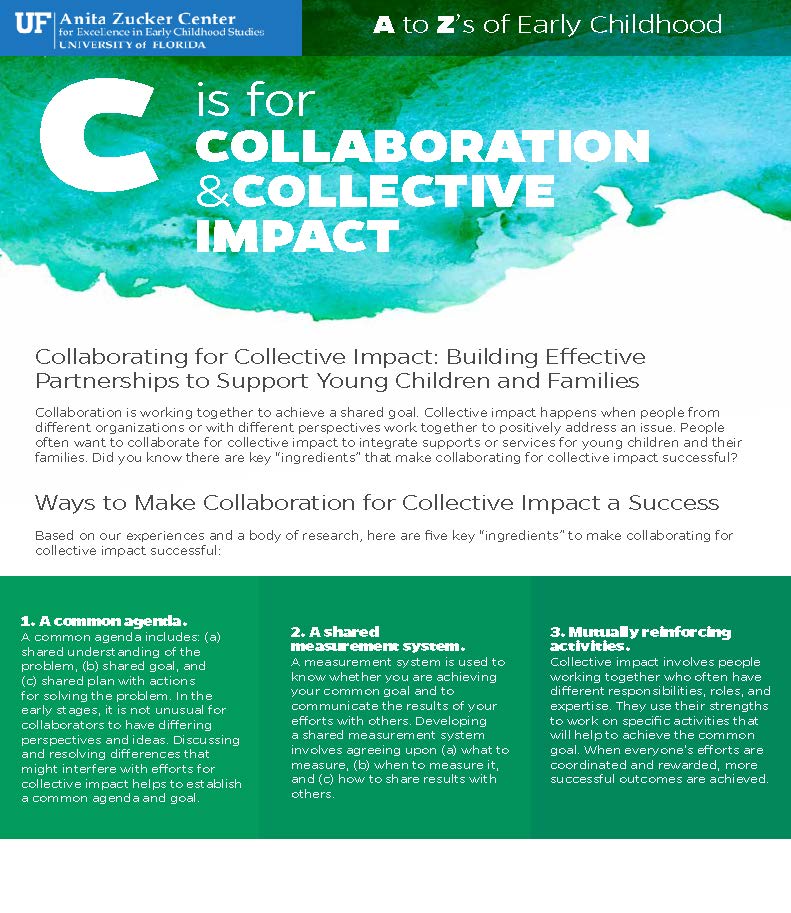A to Z’s of Early Childhood
The Science of Child Development and Learning
C is for Collaboration and Collective Impact
Building Effective Partnerships to Support Young Children and Families
Collaboration is working together to achieve a shared goal. Collective impact happens when people from different organizations or with different perspectives work together to positively address an issue. People often want to collaborate for collective impact to integrate supports or services for young children and their families. Did you know there are key “ingredients” that make collaborating for collective impact successful?
Ways to Make Collaboration for Collective Impact a Success
Based on our experiences and a body of research, here are five key “ingredients” to make collaborating for collective impact successful:
Ingredient #1 - A common agenda
A common agenda includes: (a) shared understanding of the issue, (b) shared goal, and (c) shared plan with actions for solving the issue. In the early stages, it is not unusual for collaborators to have differing perspectives and ideas. Discussing and resolving differences that might interfere with efforts for collective impact helps to establish a common agenda and goal.
Ingredient #2 - A shared measurement system
A measurement system is used to know whether you are achieving your common goal and to communicate the results of your efforts with others. Developing a shared measurement system involves agreeing upon (a) what to measure, (b) when to measure it, and (c) how to share results with others.
Ingredient #3 - Mutually reinforcing activities
Collective impact involves people working together who often have different responsibilities, roles, and expertise. They use their strengths to work on specific activities that will help to achieve the common goal. When everyone’s efforts are coordinated and rewarded, more successful outcomes are achieved.
Ingredient #4 - Continuous communication
Ongoing and regular communication is critical for building trust between collaborators, establishing a common agenda, and maintaining coordinated efforts to achieve the common goal. Continuous communication involves ongoing and regular contact, holding regular meetings, and sharing information with collaborators between meetings.
Ingredient #5 - A "backbone support" organization
To facilitate collective impact efforts, supports are needed from a “backbone support” organization. Important roles of the backbone organization include oversight of activities, communications support, data collection, and reporting outcomes to collaborators and stakeholders.
What We Know About Collaboration and Collective Impact
Collaboration involves groups of people or organizations who interact using shared norms, rules, and structures to achieve a common goal. 1
Although collaborators have common interests, they also have self-interests. Collaboration works when collaborators have their common and self-interests met.1
Collective impact is a specific type of collaboration that involves individuals from many organizations working together to solve a social issue.2
Collective impact initiatives are more effective for making large-scale changes related to social issues than interventions implemented by individual organizations.3
What We Are Doing
The Anita Zucker Center participates in collective impact initiatives to enhance services and supports for young children and their families.
Learn More:
- Community Celebrates Opening of New CHILD Center
In 2018, the Southwest Advocacy Group (SWAG), in partnership with the Anita Zucker Center and other community groups, opened the CHILD Center, a community-based early learning collaborative in Gainesville. - Starting Ahead. Staying Ahead. Early Childhood National Summit
Learn more about Starting Ahead Staying Ahead, conveyed by the University of Florida in 2017, a national summit on health, education, and policy. - Tri-County Cradle to Career Collaborative
This collaborative uses a collective impact model to address inequities in school and learning. - Center Members Collaborate with FSU and the Early Steps State Office on Professional Development for Providers
With the help of Early Steps, UF and FSU are collaborating on professional development at 15 centers in Florida. - SWAG Honors Co-Founder Joan Canton
In February of 2020, SWAG and the CHILD Center dedicated the new playground to Joan Canton, who was a great example of a collaborator who works toward collective impact in her community. - Children’s Trust of Alachua County
Dr. Patricia Snyder serves on the board of directors for the Trust. Learn more about its history and continued efforts.
Other Resources
- Strive Together
This nationwide collaborative guides communities through actionable milestones with the goal of creating more equitable outcomes for children. - Stanford Social Innovation Review—Collective Impact Articles
Learn more about why researchers at Stanford say collective impact is essential for social innovation.
References
- Wood, D. J., & Gray, B. (1991). Toward a comprehensive theory of collaboration. The Journal of Applied Behavioral Science, 27(2), 139-162. https://doi.org/10.1177/0021886391272001
- Prange, K., Allen, J. A., & Reiter-Palmon, R. (2016). Collective impact versus collaboration: Sides of the same coin OR different phenomenon? Metropolitan Universities, 27(1), 86-96. https://journals.iupui.edu/index.php/muj/article/view/21119
- Kania, J., & Kramer, M. (2011). Collective impact. Stanford Social Innovation Review, 9(1), 36-41. https://doi.org/10.48558/5900-KN19
Receive Additional Support
The complete 3R’s of Early Learning downloadable video recordings (including the A to Z’s of Early Childhood) for use in the field of childhood development to facilitate learning are available for purchase.
If you would like to purchase these resources or speak with a member of our team for help in providing professional development, please complete this contact form.

